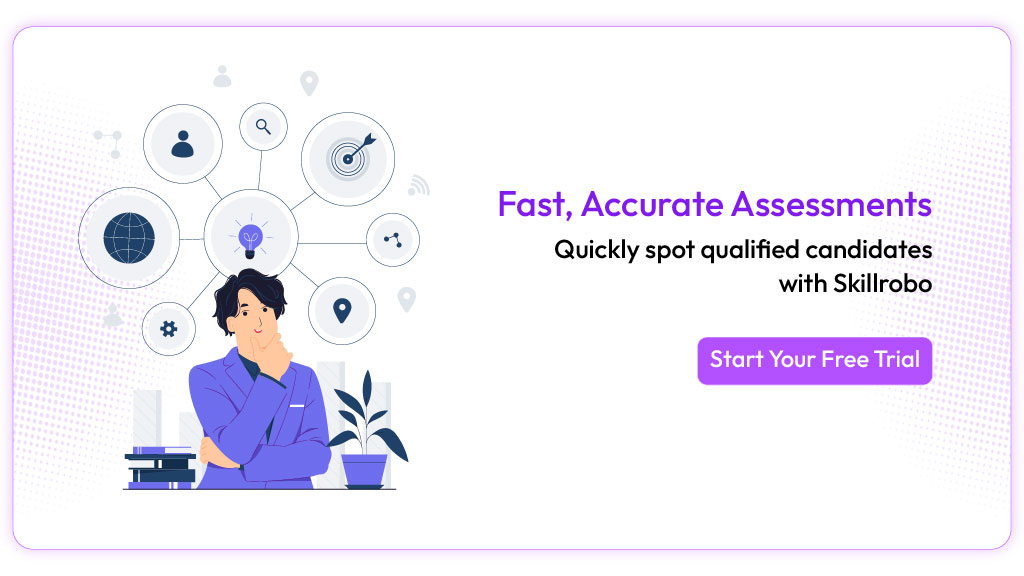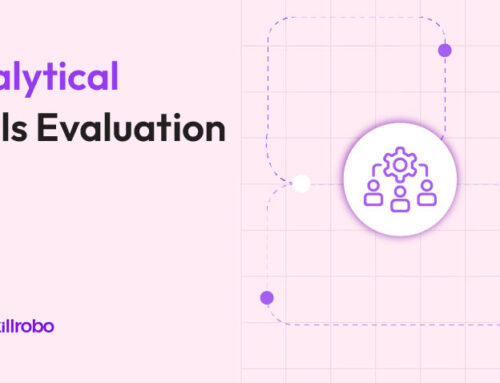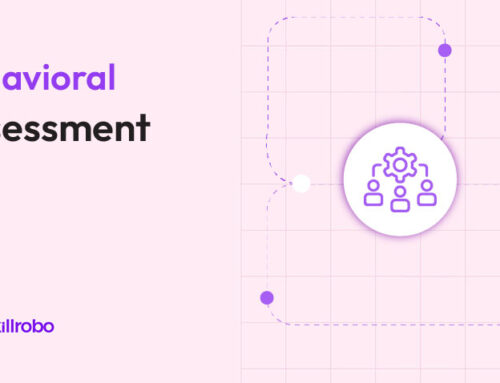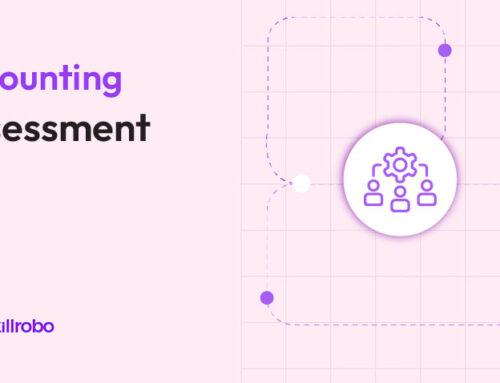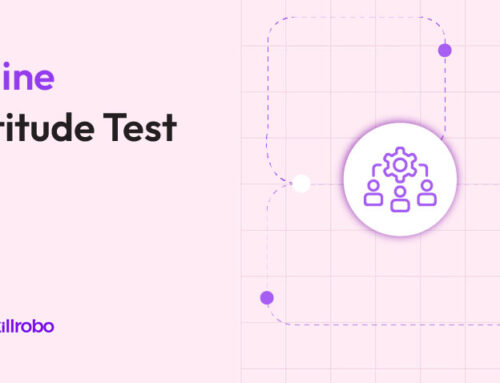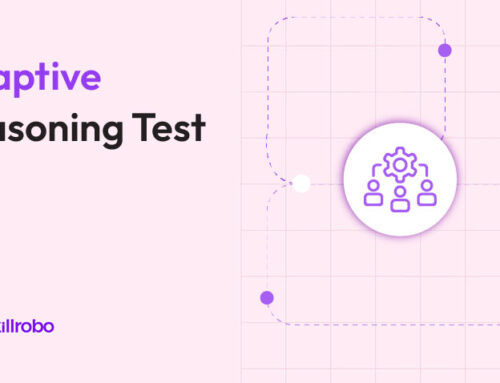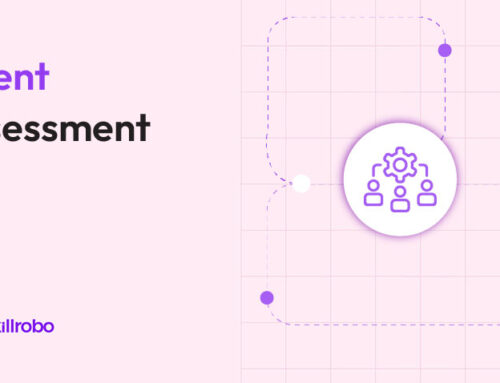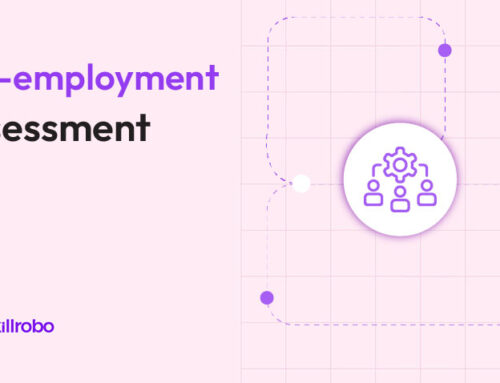Table of Contents
- Key Takeaways
- Digital Fluency is Now a Business Imperative
- What is a Digital Skills Assessment?
- Why Digital Skills Assessments Are Important
- How Digital Skills Are Assessed
- Implementing Digital Skills Assessments
- Step-by-Step Approach to Implementing Digital Skill Assessments
- Why Skillrobo Is the Best Digital Skills Assessment Platform
- Conclusion: Building a Future-Ready Workforce
Related articles
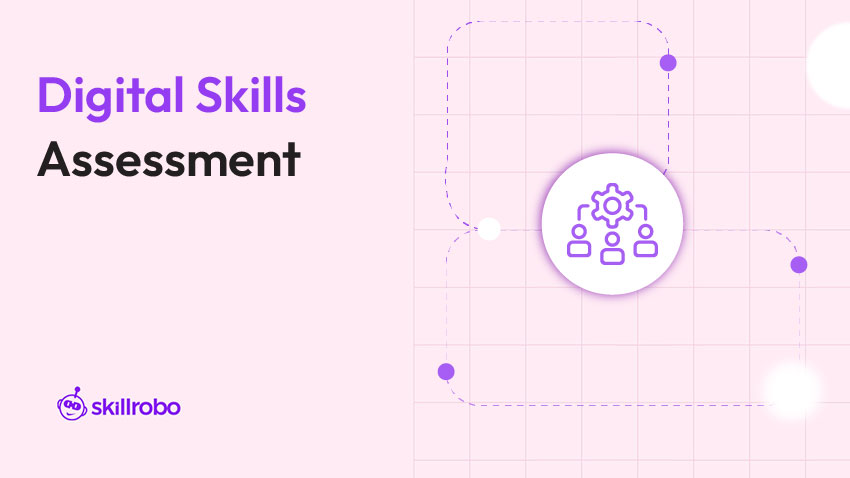
Key Takeaways
- Digital skills assessments identify current capability gaps, helping businesses implement targeted training aligned with specific role requirements and evolving digital demands.
- These assessments improve workforce productivity by ensuring employees possess the digital knowledge necessary to perform tasks accurately and efficiently across platforms.
- Digital literacy evaluations offer a fair, standardized way to measure technical competencies across departments, reducing bias and supporting inclusive hiring practices.
- When implemented correctly, digital assessments empower smarter hiring decisions, promote continuous upskilling, and prepare teams for future digital transformation challenges.
Digital Fluency is Now a Business Imperative
Digital skills assessment has become a critical tool for organizations navigating today's technology-driven workplace. As businesses increasingly rely on digital tools—from data analytics to virtual collaboration—understanding your team's digital proficiency is no longer optional. A well-executed assessment helps pinpoint existing competencies, highlight skill gaps, and inform workforce development strategies. It also supports digital transformation efforts by aligning training investments with actual business needs, improving productivity, and reducing inefficiencies tied to poor digital literacy.
In this blog, we explore what digital skills assessments are, why they matter, and how to implement them effectively across your organization.
What is a Digital Skills Assessment?
A digital skills assessment is a structured evaluation used to measure an individual's ability to perform tasks using digital tools, systems, and platforms. These assessments aren't just for IT professionals—they apply across functions like HR, finance, operations, and marketing, where digital proficiency is now essential.
Typically, assessments cover tasks like managing emails, handling spreadsheets, navigating cloud-based tools, maintaining cybersecurity hygiene, and using digital communication platforms. Since these are aligned with actual job functions, they provide more actionable data than generic tests.
Organizations often use a mix of simulations, role-based tasks, and self-evaluation to understand digital readiness. For example, companies designing digital assessments tailored to job roles can refer to proven strategies for creating effective pre-employment skill assessments that reflect real workplace needs.
Why Digital Skills Assessments Are Important
Digital skills assessments are no longer optional—they're foundational to smart, future-ready workforce strategies. These evaluations give employers visibility into actual capabilities, helping guide hiring, training, and transformation efforts.
1. Identifying Skill Gaps
Understanding exactly where digital skill gaps lie is the first step toward closing them. Assessments uncover weaknesses in areas like spreadsheet proficiency, cybersecurity awareness, and cloud collaboration tools. This ensures upskilling efforts are precise and effective. Many companies use assessments to proactively plan development pathways—an approach reinforced in Skillrobo's guide to identifying skill gaps.
2. Enhancing Workforce Productivity
When employees are confident using digital tools, efficiency rises. Tasks that once required hours can be completed in minutes through automation and better workflows. Digital assessments ensure teams are equipped to use the tools already embedded in your operations, eliminating downtime, frustration, and manual rework.
3. Supporting Transformation Strategies
Introducing new technologies without confirming employee readiness leads to adoption failures. A digital skills assessment helps organizations align people and technology, allowing transformation initiatives to succeed with minimal resistance or disruption.
4. Improving Recruitment and Onboarding
Digital evaluations during hiring help recruiters go beyond polished résumés to identify real-world competency. For example, assessing email communication or CRM usage ensures that candidates are job-ready. Onboarding becomes smoother when training is personalized based on assessment performance.
5. Enabling Data-Driven L&D Programs
Learning and development efforts often fall flat due to misalignment. With assessment data, training programs can be built around actual needs. This creates a more engaging and ROI-driven learning culture, driven by insight, not assumption.
How Digital Skills Are Assessed
There is no one-size-fits-all approach when it comes to evaluating digital competencies. The method used often depends on the specific role, level of responsibility, and organizational objectives. However, effective assessment of digital skills shares one trait—they provide measurable, role-relevant insights into a person's ability to perform in a digital-first environment.
1. Standardized Digital Tools Testing
2. Scenario-Based Simulations
Simulations offer a hands-on way to evaluate how candidates or employees perform in real-life situations. For example, a marketer might be asked to analyze digital campaign data using analytics software, while a customer support agent could be evaluated on live chat response scenarios. These simulations are especially valuable because they test not only knowledge but application.
3. Self-Assessments and 360-Degree Feedback
For internal benchmarking or learning and development planning, self-assessment tools are useful in capturing perceived skill levels. When combined with 360-degree feedback from managers or peers, they offer a holistic view of both confidence and capability, helping to identify over- or under-estimations in digital fluency.
4. Performance-Based Assessments
Rapidly gaining traction, performance-based assessments place users in a task-specific, interactive environment. Rather than simply answering multiple-choice questions, candidates complete job-relevant digital tasks, such as formatting data reports, scheduling virtual meetings, or creating cloud-based folders. This method is particularly effective for measuring applied skills in high-stakes or technical roles.
5. Customized Internal Assessments
Organizations looking to scale digital skill evaluations often turn to platforms like Skillrobo. With its customized employee skill assessment strategy, Skillrobo allows HR teams to create tailored assessments for different roles, departments, or seniority levels. This ensures each digital skills assessment tool reflects the actual competencies required for job success.
As digital demands continue to evolve, organizations that embrace a mix of these approaches are better positioned to identify gaps, deliver targeted training, and hire talent that's ready for a digitally empowered workplace.
Implementing Digital Skills Assessments
Implementing a digital skills assessment effectively requires a strategic, step-by-step approach aligned with your organization's talent and technology goals. It begins with setting clear objectives—whether the aim is to improve hiring accuracy, identify internal digital skill gaps, or enhance long-term workforce development strategies.
Once the purpose is defined, organizations must select or create the right digital skills assessment tool tailored to specific job roles. These tools should reflect actual job tasks and digital environments to ensure that assessments offer meaningful and predictive outcomes. Platforms like Skillrobo's online assessment tool allow businesses to customize evaluations for different levels of digital proficiency, making them ideal for both recruitment and internal development.
After conducting the assessment, the results must be analyzed for actionable insights. This data helps build personalized training programs, shape hiring strategies, and guide broader talent planning. Whether you're onboarding a new team or rolling out an enterprise-wide digital literacy skills assessment, it's crucial to begin with a pilot group to gather feedback, optimize the process, and avoid scaling inefficiencies.
Step-by-Step Approach to Implementing Digital Skill Assessments
Implementing a digital skill assessment requires more than just selecting a test—it demands a thoughtful, structured approach aligned with your business goals. Whether you're hiring, upskilling, or benchmarking team capabilities, a step-by-step framework helps ensure the assessment is relevant, accurate, and actionable. Below is a proven process to roll out digital skill assessments effectively across your organization.
- Define Clear Objectives – Identify whether the goal is hiring, upskilling, team benchmarking, or workforce planning.
- Select or Build the Right Tool – Choose a digital assessment tool that aligns with your goals. It should reflect actual job tasks and required competencies.
- Map Skills to Roles – Determine the digital skills most relevant to each job function, such as data literacy, software proficiency, or cybersecurity awareness.
- Design Job-Relevant Assessments – Create tasks, quizzes, or simulations that mimic real-world job expectations for better accuracy and relevance.
- Pilot the Assessment – Test the process with a small internal group to ensure clarity, difficulty balance, and system usability.
- Conduct the Assessment at Scale – Roll out the finalized version across candidates or teams using standardized procedures.
- Analyze and Interpret Results – Evaluate performance data to identify strengths, weaknesses, and actionable patterns.
- Translate Insights into Action – Use findings to personalize training programs, refine hiring strategies, or forecast future workforce needs.
Why Skillrobo Is the Best Digital Skills Assessment Platform
When it comes to evaluating digital fluency across roles, Skillrobo stands out as a reliable, scalable, and customizable assessment solution. Whether you're assessing spreadsheet skills, cloud collaboration, digital communication, or platform-specific tool usage, Skillrobo provides everything you need in one seamless platform.
Skillrobo allows hiring managers and L&D teams to assess digital skills through task-based simulations, self-assessments, and real-time analytics. From recruitment to workforce upskilling, it supports every phase of the talent lifecycle with built-in test templates and role-specific evaluation models.
Key Advantages:
- Role-Relevant Assessments – Test real-world tasks aligned with job expectations, not generic quizzes.
- Custom Test Builder – Create assessments tailored to your organization's digital tools and workflows.
- Secure Remote Testing – Includes browser lockdown and proctoring options for distributed teams.
- Behavioral + Technical Evaluation – Measure both tool usage and digital problem-solving capabilities.
- Insightful Reporting – Real-time performance data to inform hiring, onboarding, or training strategies.
If your organization is serious about digital transformation, Skillrobo is the assessment platform built for it.
Conclusion: Building a Future-Ready Workforce
A digitally fluent workforce is no longer optional—it's essential. As businesses evolve to meet new challenges, the need for skill assessment for digital literacy becomes even more important. Digital skills assessments provide the clarity and direction needed to build teams that are adaptable, tech-savvy, and aligned with long-term organizational goals.
By making these assessments part of recruitment, training, and performance management processes, organizations gain a competitive edge—not only in talent acquisition but in transformation readiness and resilience.
If you're aiming to build smarter teams equipped for tomorrow's challenges, it starts with knowing where your digital capabilities stand today.
Sign up for Skillrobo and start assessing digital skills with precision and confidence.

Key Takeaways
- Digital skills assessments identify current capability gaps, helping businesses implement targeted training aligned with specific role requirements and evolving digital demands.
- These assessments improve workforce productivity by ensuring employees possess the digital knowledge necessary to perform tasks accurately and efficiently across platforms.
- Digital literacy evaluations offer a fair, standardized way to measure technical competencies across departments, reducing bias and supporting inclusive hiring practices.
- When implemented correctly, digital assessments empower smarter hiring decisions, promote continuous upskilling, and prepare teams for future digital transformation challenges.
Digital Fluency is Now a Business Imperative
Digital skills assessment has become a critical tool for organizations navigating today's technology-driven workplace. As businesses increasingly rely on digital tools—from data analytics to virtual collaboration—understanding your team's digital proficiency is no longer optional. A well-executed assessment helps pinpoint existing competencies, highlight skill gaps, and inform workforce development strategies. It also supports digital transformation efforts by aligning training investments with actual business needs, improving productivity, and reducing inefficiencies tied to poor digital literacy.
In this blog, we explore what digital skills assessments are, why they matter, and how to implement them effectively across your organization.
What is a Digital Skills Assessment?
A digital skills assessment is a structured evaluation used to measure an individual's ability to perform tasks using digital tools, systems, and platforms. These assessments aren't just for IT professionals—they apply across functions like HR, finance, operations, and marketing, where digital proficiency is now essential.
Typically, assessments cover tasks like managing emails, handling spreadsheets, navigating cloud-based tools, maintaining cybersecurity hygiene, and using digital communication platforms. Since these are aligned with actual job functions, they provide more actionable data than generic tests.
Organizations often use a mix of simulations, role-based tasks, and self-evaluation to understand digital readiness. For example, companies designing digital assessments tailored to job roles can refer to proven strategies for creating effective pre-employment skill assessments that reflect real workplace needs.
Why Digital Skills Assessments Are Important
Digital skills assessments are no longer optional—they're foundational to smart, future-ready workforce strategies. These evaluations give employers visibility into actual capabilities, helping guide hiring, training, and transformation efforts.
1. Identifying Skill Gaps
Understanding exactly where digital skill gaps lie is the first step toward closing them. Assessments uncover weaknesses in areas like spreadsheet proficiency, cybersecurity awareness, and cloud collaboration tools. This ensures upskilling efforts are precise and effective. Many companies use assessments to proactively plan development pathways—an approach reinforced in Skillrobo's guide to identifying skill gaps.
2. Enhancing Workforce Productivity
When employees are confident using digital tools, efficiency rises. Tasks that once required hours can be completed in minutes through automation and better workflows. Digital assessments ensure teams are equipped to use the tools already embedded in your operations, eliminating downtime, frustration, and manual rework.
3. Supporting Transformation Strategies
Introducing new technologies without confirming employee readiness leads to adoption failures. A digital skills assessment helps organizations align people and technology, allowing transformation initiatives to succeed with minimal resistance or disruption.
4. Improving Recruitment and Onboarding
Digital evaluations during hiring help recruiters go beyond polished résumés to identify real-world competency. For example, assessing email communication or CRM usage ensures that candidates are job-ready. Onboarding becomes smoother when training is personalized based on assessment performance.
5. Enabling Data-Driven L&D Programs
Learning and development efforts often fall flat due to misalignment. With assessment data, training programs can be built around actual needs. This creates a more engaging and ROI-driven learning culture, driven by insight, not assumption.
How Digital Skills Are Assessed
There is no one-size-fits-all approach when it comes to evaluating digital competencies. The method used often depends on the specific role, level of responsibility, and organizational objectives. However, effective assessment of digital skills shares one trait—they provide measurable, role-relevant insights into a person's ability to perform in a digital-first environment.
1. Standardized Digital Tools Testing
2. Scenario-Based Simulations
Simulations offer a hands-on way to evaluate how candidates or employees perform in real-life situations. For example, a marketer might be asked to analyze digital campaign data using analytics software, while a customer support agent could be evaluated on live chat response scenarios. These simulations are especially valuable because they test not only knowledge but application.
3. Self-Assessments and 360-Degree Feedback
For internal benchmarking or learning and development planning, self-assessment tools are useful in capturing perceived skill levels. When combined with 360-degree feedback from managers or peers, they offer a holistic view of both confidence and capability, helping to identify over- or under-estimations in digital fluency.
4. Performance-Based Assessments
Rapidly gaining traction, performance-based assessments place users in a task-specific, interactive environment. Rather than simply answering multiple-choice questions, candidates complete job-relevant digital tasks, such as formatting data reports, scheduling virtual meetings, or creating cloud-based folders. This method is particularly effective for measuring applied skills in high-stakes or technical roles.
5. Customized Internal Assessments
Organizations looking to scale digital skill evaluations often turn to platforms like Skillrobo. With its customized employee skill assessment strategy, Skillrobo allows HR teams to create tailored assessments for different roles, departments, or seniority levels. This ensures each digital skills assessment tool reflects the actual competencies required for job success.
As digital demands continue to evolve, organizations that embrace a mix of these approaches are better positioned to identify gaps, deliver targeted training, and hire talent that's ready for a digitally empowered workplace.
Implementing Digital Skills Assessments
Implementing a digital skills assessment effectively requires a strategic, step-by-step approach aligned with your organization's talent and technology goals. It begins with setting clear objectives—whether the aim is to improve hiring accuracy, identify internal digital skill gaps, or enhance long-term workforce development strategies.
Once the purpose is defined, organizations must select or create the right digital skills assessment tool tailored to specific job roles. These tools should reflect actual job tasks and digital environments to ensure that assessments offer meaningful and predictive outcomes. Platforms like Skillrobo's online assessment tool allow businesses to customize evaluations for different levels of digital proficiency, making them ideal for both recruitment and internal development.
After conducting the assessment, the results must be analyzed for actionable insights. This data helps build personalized training programs, shape hiring strategies, and guide broader talent planning. Whether you're onboarding a new team or rolling out an enterprise-wide digital literacy skills assessment, it's crucial to begin with a pilot group to gather feedback, optimize the process, and avoid scaling inefficiencies.
Step-by-Step Approach to Implementing Digital Skill Assessments
Implementing a digital skill assessment requires more than just selecting a test—it demands a thoughtful, structured approach aligned with your business goals. Whether you're hiring, upskilling, or benchmarking team capabilities, a step-by-step framework helps ensure the assessment is relevant, accurate, and actionable. Below is a proven process to roll out digital skill assessments effectively across your organization.
- Define Clear Objectives – Identify whether the goal is hiring, upskilling, team benchmarking, or workforce planning.
- Select or Build the Right Tool – Choose a digital assessment tool that aligns with your goals. It should reflect actual job tasks and required competencies.
- Map Skills to Roles – Determine the digital skills most relevant to each job function, such as data literacy, software proficiency, or cybersecurity awareness.
- Design Job-Relevant Assessments – Create tasks, quizzes, or simulations that mimic real-world job expectations for better accuracy and relevance.
- Pilot the Assessment – Test the process with a small internal group to ensure clarity, difficulty balance, and system usability.
- Conduct the Assessment at Scale – Roll out the finalized version across candidates or teams using standardized procedures.
- Analyze and Interpret Results – Evaluate performance data to identify strengths, weaknesses, and actionable patterns.
- Translate Insights into Action – Use findings to personalize training programs, refine hiring strategies, or forecast future workforce needs.
Why Skillrobo Is the Best Digital Skills Assessment Platform
When it comes to evaluating digital fluency across roles, Skillrobo stands out as a reliable, scalable, and customizable assessment solution. Whether you're assessing spreadsheet skills, cloud collaboration, digital communication, or platform-specific tool usage, Skillrobo provides everything you need in one seamless platform.
Skillrobo allows hiring managers and L&D teams to assess digital skills through task-based simulations, self-assessments, and real-time analytics. From recruitment to workforce upskilling, it supports every phase of the talent lifecycle with built-in test templates and role-specific evaluation models.
Key Advantages:
- Role-Relevant Assessments – Test real-world tasks aligned with job expectations, not generic quizzes.
- Custom Test Builder – Create assessments tailored to your organization's digital tools and workflows.
- Secure Remote Testing – Includes browser lockdown and proctoring options for distributed teams.
- Behavioral + Technical Evaluation – Measure both tool usage and digital problem-solving capabilities.
- Insightful Reporting – Real-time performance data to inform hiring, onboarding, or training strategies.
If your organization is serious about digital transformation, Skillrobo is the assessment platform built for it.
Conclusion: Building a Future-Ready Workforce
A digitally fluent workforce is no longer optional—it's essential. As businesses evolve to meet new challenges, the need for skill assessment for digital literacy becomes even more important. Digital skills assessments provide the clarity and direction needed to build teams that are adaptable, tech-savvy, and aligned with long-term organizational goals.
By making these assessments part of recruitment, training, and performance management processes, organizations gain a competitive edge—not only in talent acquisition but in transformation readiness and resilience.
If you're aiming to build smarter teams equipped for tomorrow's challenges, it starts with knowing where your digital capabilities stand today.
Sign up for Skillrobo and start assessing digital skills with precision and confidence.

